21 Jun Why mycotoxins make you lose the money invested in feed?

Mycotoxins are toxic secondary metabolites produced by molds mainly belonging to the genera Aspergillus, Penicillium and Fusarium. Although the best known consequences of mycotoxins are their clinical (diseases) and subclinical (productivity losses) effects on farm animals, the reduction of the value of crops and complete feeds is a lesser known but very important repercussion. It is estimated to cause losses of nearly one billion USD per year to US farmers (Schmale et al, 2014).
It is calculated that, depending on ingredients and target specie, mycotoxins can reduce up to 13% of the nutritional value of complete feed (Han et al, 2008).
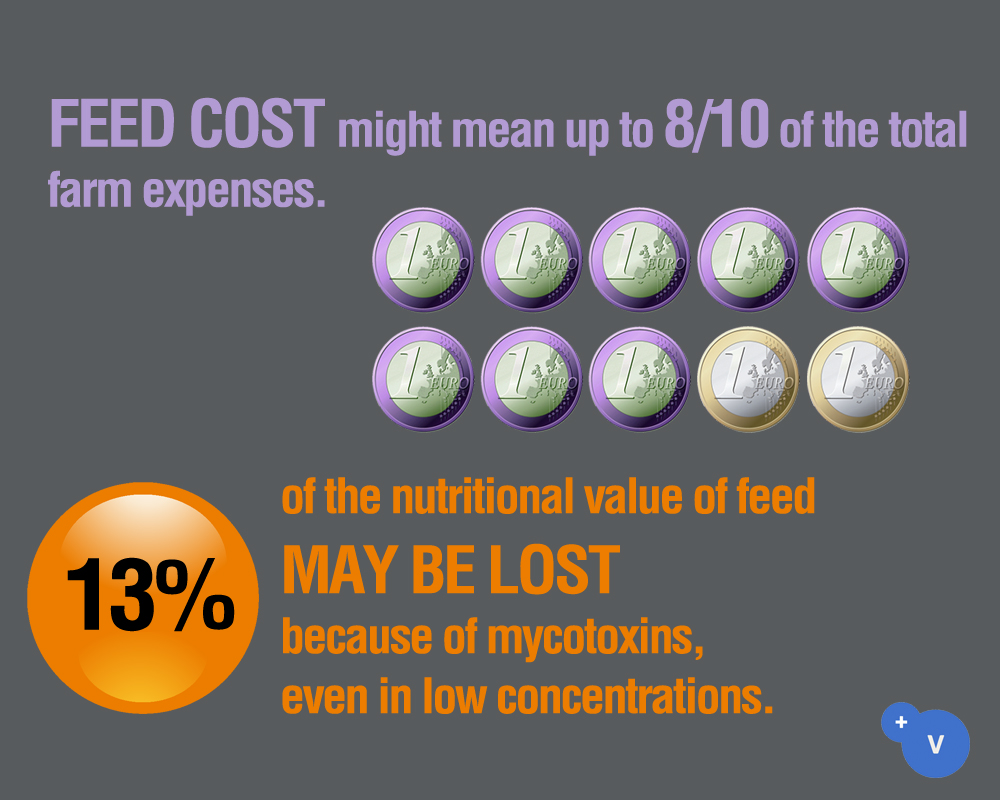
Sources: FEFANA, 2011; Han et al, 2008.
Mycotoxins impair feed use in 6 different ways that will be described in this article.
1) LOSES DUE TO GROWTH OF MOLD IN FEED OR RAW MATERIALS
Feed or raw materials act as substrate for molds, which use nutrients for their own metabolism. The nutritional value of grains, oilseeds and complete feeds is altered by the growth of molds (Jaramillo, 2010; Richardson, 2007):
- Losses of metabolizable energy in corn due to mould growth range from 5% to 25%.
- Molds are able to secrete lipases and use feed triglycerides as a source of energy. Moldy feed may have lost up to 3% of fats and oils.
- Protein content can be reduced up to 2%. The amino acids cysteine, lysine and arginine are more affected than others.
- Vitamins A, D, E, K, B12, thiamine, riboflavin, niacin, pantothenic acid, pyridoxine and niacin are also consumed by fungi for their own growth.
Spoilage by molds also generates problems of flowability (bridging, clumps, etc) and high temperatures in silos, besides producing unpleasant flavors and impairing palatability. (Canadian Grain Commission, 2009).
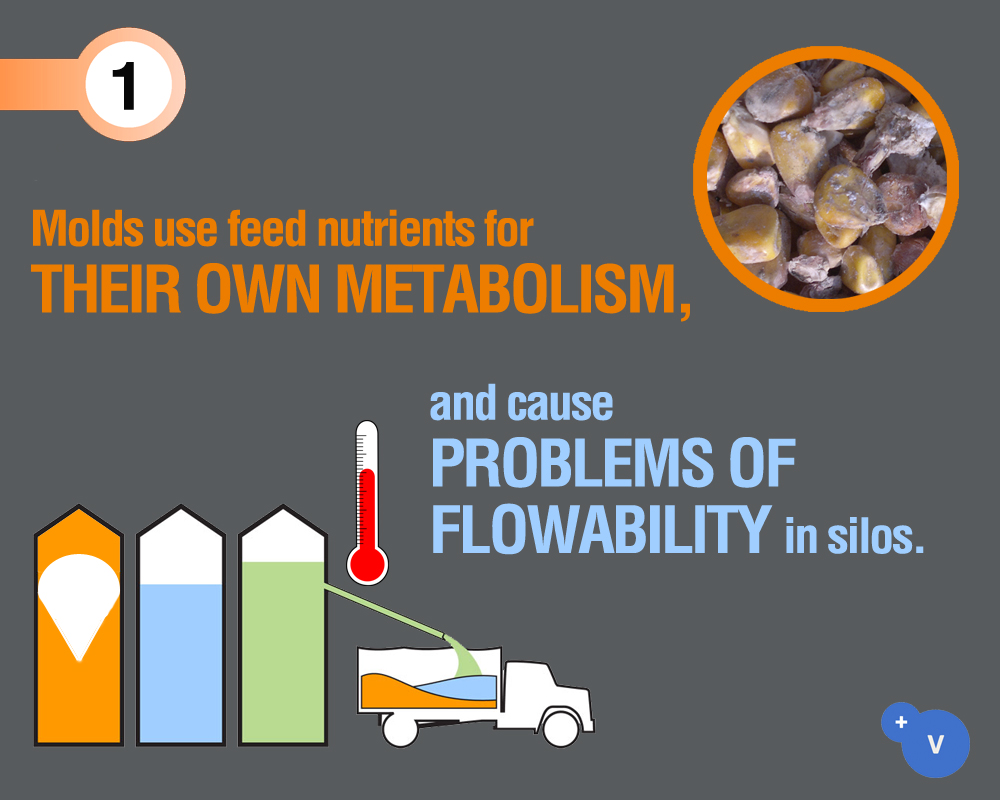
2) WORSENING OF DIGESTIVE ENZYMATIC ACTIVITY
Optimal activity of digestive enzymes is essential for proper feed use. Even in low, realistic concentrations, mycotoxins exert a negative effect on the digestive enzymes.
Due to negative effect of aflatoxins on pancreas, the activity of the digestive enzymes secreted by this organ (amylase, trypsin and chymotrypsin) is impaired, and it has been determined that reduced feed intake and nutrient deficiency during aflatoxicosis is caused by pancreatic toxicity (Applegate et al, 2009). Fumonisins reduce the enzymatic activity of alkaline phosphatase and aminopeptidase in swine (Matur et al, 2010).
In some species, aflatoxins reduce bile secretion (Carrillo at al, 1982). Bile contains bile acids, which are critical for digestion and absorption of fats and fat-soluble vitamins in the small intestine.
Several studies confirmed that mycotoxins, especially aflatoxins, ochratoxin A and DON, reduced apparent digestibility of crude protein and impaired metabolizable energy. Broilers and ducks are the most affected species (Han et al, 2008; Danicke et al, 2002).
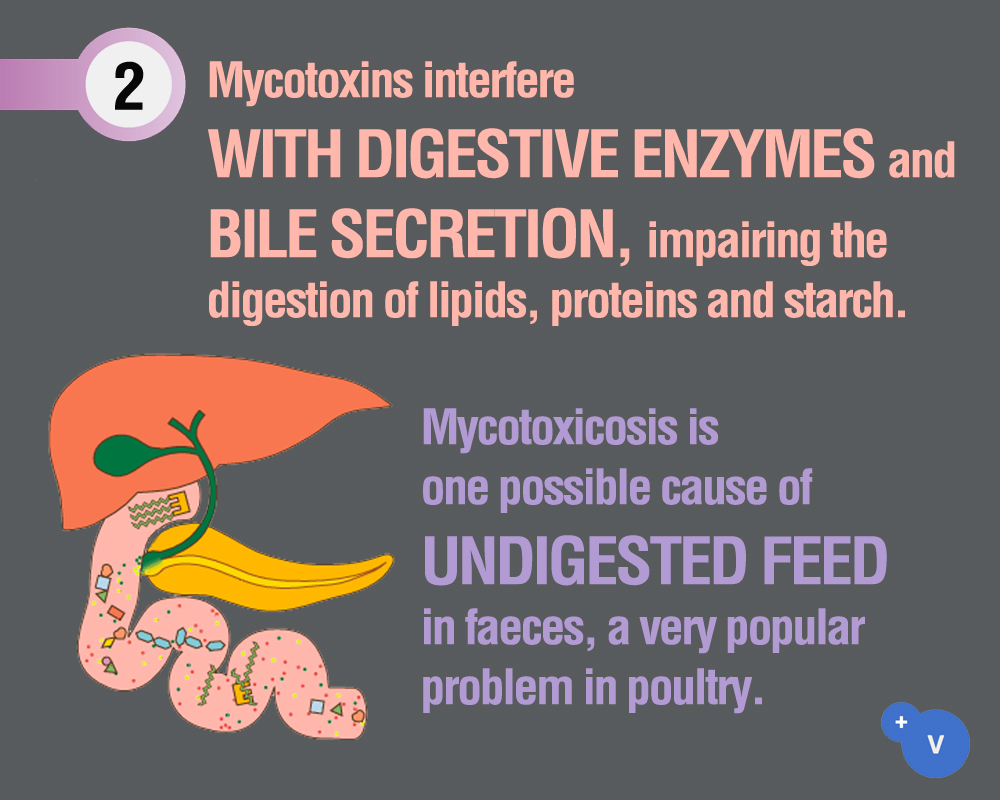
3) TOXICITY ON SURFACES OF DIGESTIVE SYSTEM
The bioavailability of mycotoxins is very diverse and depends on the chemical structure of each mycotoxin and on the animal specie. 80% of mycotoxins are absorbed in the upper part of digestive system (stomach/crop, duodenum and proximal part of the jejunum).
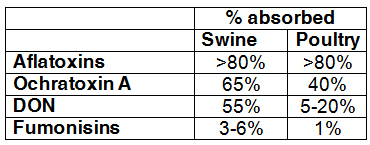
Ruminants constitute an exception as most of the mycotoxins are detoxified by microbial population in rumen (Diaz, 2005).
Many mycotoxins undergo enterohepatic circulation, which means that, after a mycotoxins is absorbed from digestive system to bloodstream, circulates to liver and then to bile, returning to digestive system by entering small intestine.
The substantial amounts of mycotoxins that are not absorbed, together with those that have re-entered the digestive system via enterohepatic cycle, remain in the lumen and are highly toxic to the epithelium of digestive system.
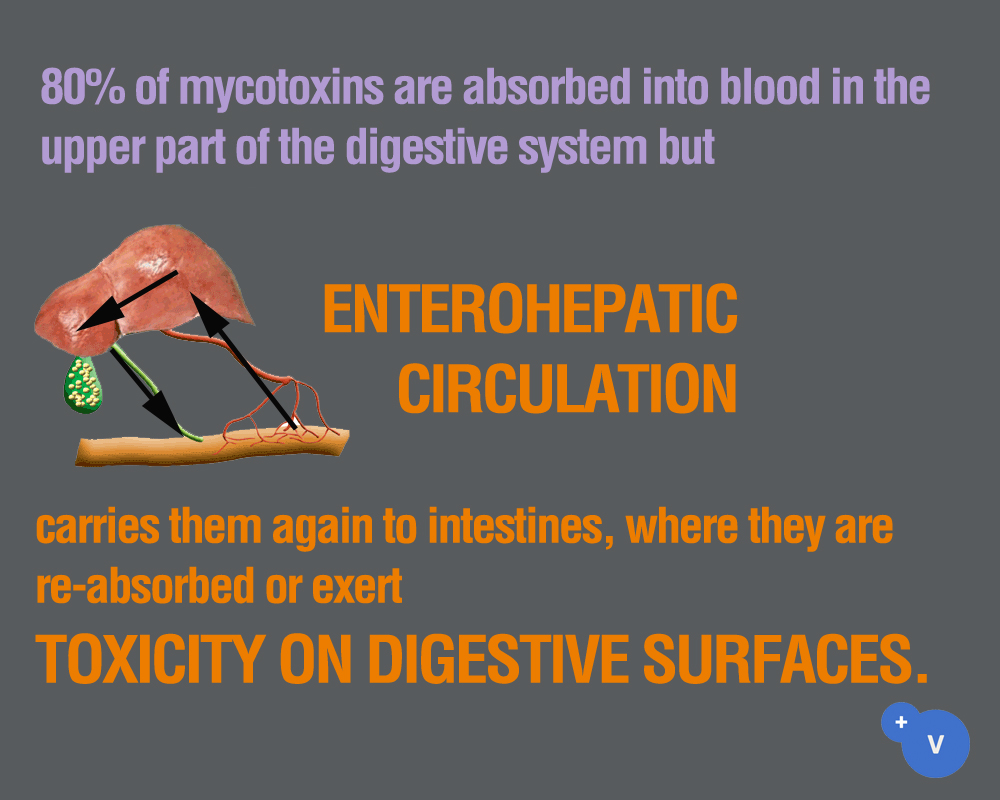
For the reasons that just exposed, the gastrointestinal tract is the first and main system affected by the toxicity of mycotoxins.
Trichothecenes (mainly T-2 toxin, H T-2 toxin, DAS and DON) are the most caustic mycotoxins for intestinal surfaces, but moniliformin and fumonisins are highly toxic too (Murugesan, 2013).
Trichothecenes are cytotoxic, interfere with protein synthesis and also are able to stop cell profileration, causing erosions in mouth, esophagus, gizzard/stomach and intestines. In small intestine, T-2 is able to produce necrosis of the villi, reducing nutrient absorption. Refusal to consume contaminated feedstuff is the typical sign of fusariotoxicosis. Pigs may also show vomiting.
Fumonisins and moniliformin toxicity is relevant in oral epithelium, as they are able to dissolve the protoplasm of the cells of mouth mucosa.
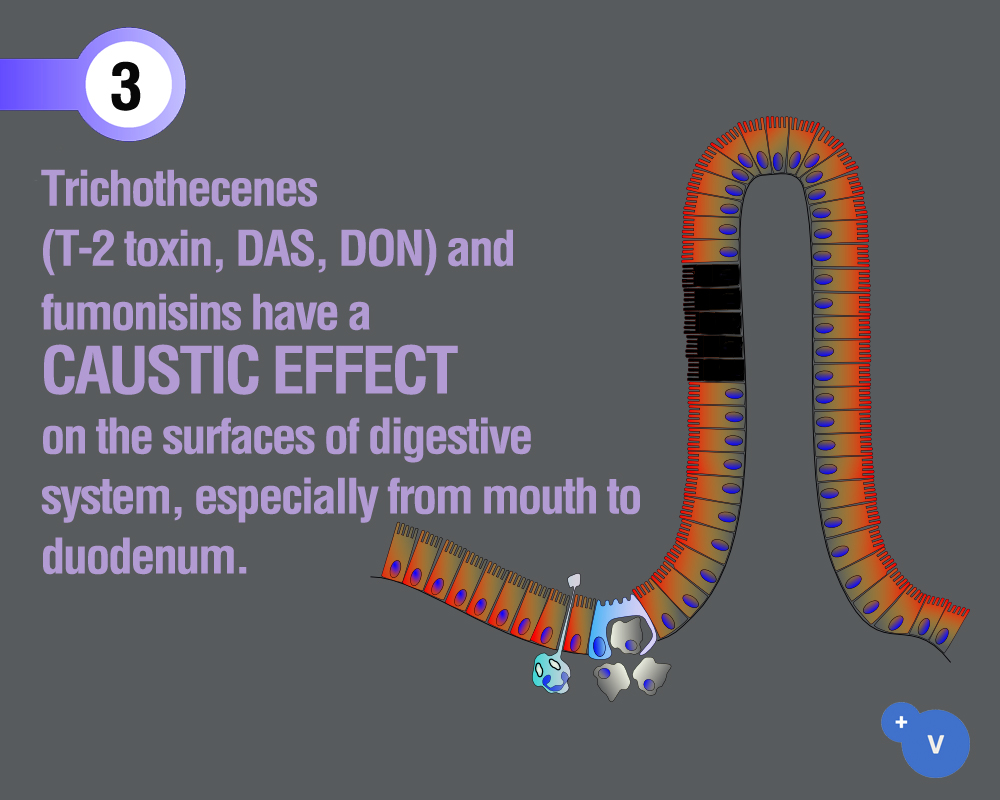
As a secondary effect of such caustic effect, mycotoxins (DON, T-2 and zearalenone) increase the permeability of enterocytes and reduce the secretion of mucus that covers digestive , reducing the barrier function of intestine. (Obremski et al, 2008; (Montagne et al., 2004). The presence of Fusarium mycotoxins (trichothecenes, zearalenone and fumonisins) make the animals more susceptible to coccidia, E.coli and Salmonella sp. (Vandenbroucke et al, 2011; Oswald et al, 2003; Girgis et al, 2010).
It becomes easier for toxic substances and pathogenic microorganisms to enter the bloodstream and induce general intoxications or infections.
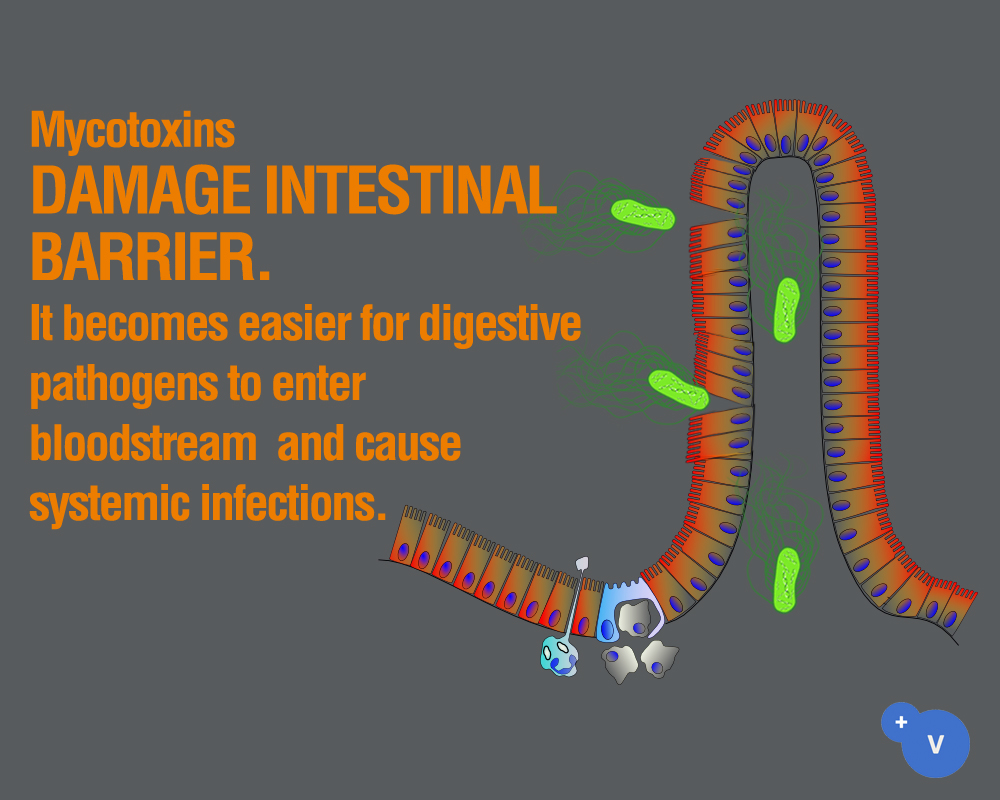
4) IMPAIRING NUTRIENT ABSORPTION
Mycotoxins impair the absorption of nutrients in intestine by blocking the transportation of substances from intestinal lumen into bloodstream:
- Glucose absorption is decreased by DON and ochratoxin A (Maresca et al, 2002). Glucose is the main source of energy in the animal.
- DON impairs the absorption of amino acids (Maresca et al, 2002).
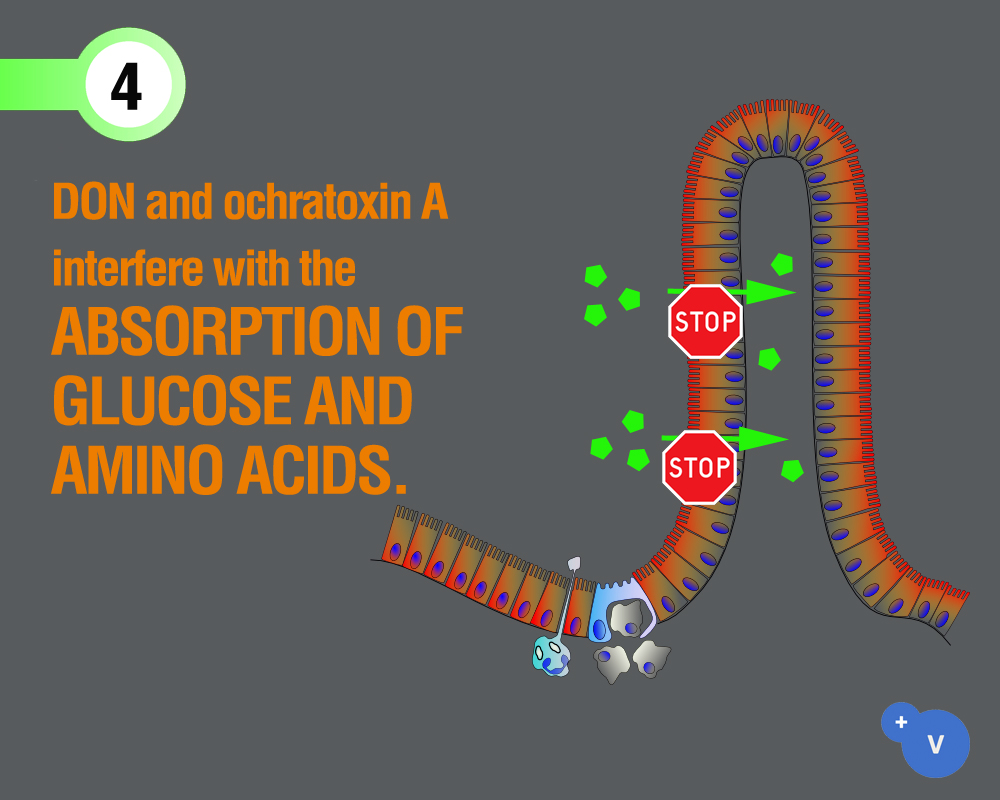
5) Interference with metabolism of nutrients and pharmacologicals
Mycotoxins alter the metabolism of various nutrients and drugs once they have been absorbed:
- Aflatoxins and fumonisins interfere in fat metabolism and favor the accumulation of fat in liver (Siloto et al, 2013).
- Trichothecenes, zearalenone (ZEN) and fumonisins interfere with protein synthesis in different ways (Smith, 1982).
- Aflatoxins and T-2 reduce the levels of B group vitamins and vitamin E in plasma (Bains, 2002)
- Many mycotoxins (zearalenone, T-2) inhibit functioning of cytochrome P450, a group of enzymes involved in the metabolism of many pharmaceuticals (ionophore antibiotics, fluoroquinolones, enrofloxacion, etc). (Goosens et al, 2013)
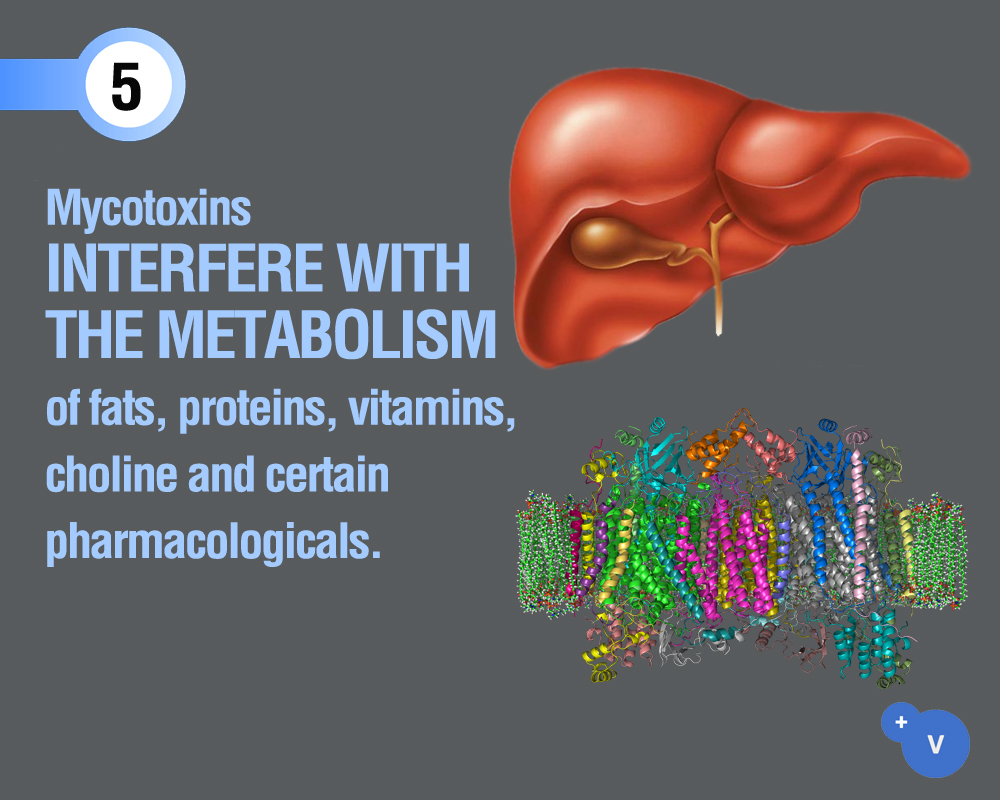
6) Effect on intestinal flora
In ruminants, mycotoxins are metabolized, and in many cases detoxified, by rumen flora.
In monogastrics, the effect of mycotoxins on intestinal microbiota is not clearly understood yet, but, as mycotoxins have antibacterial activity, presumably can cause imbalances in intestinal microbial populations. In fact, it has been observed that DON can increase the count of aerobic bacteria (Wache et al, 2009) and that can promote the growth of a group of species related to chronic intestinal inflammation (Saint-Cyr et al, 2013).
In contrast, some identified intestinal bacterial strains that promote metabolism, binding or detoxification of mycotoxins, such as some lactic acid bacteria.
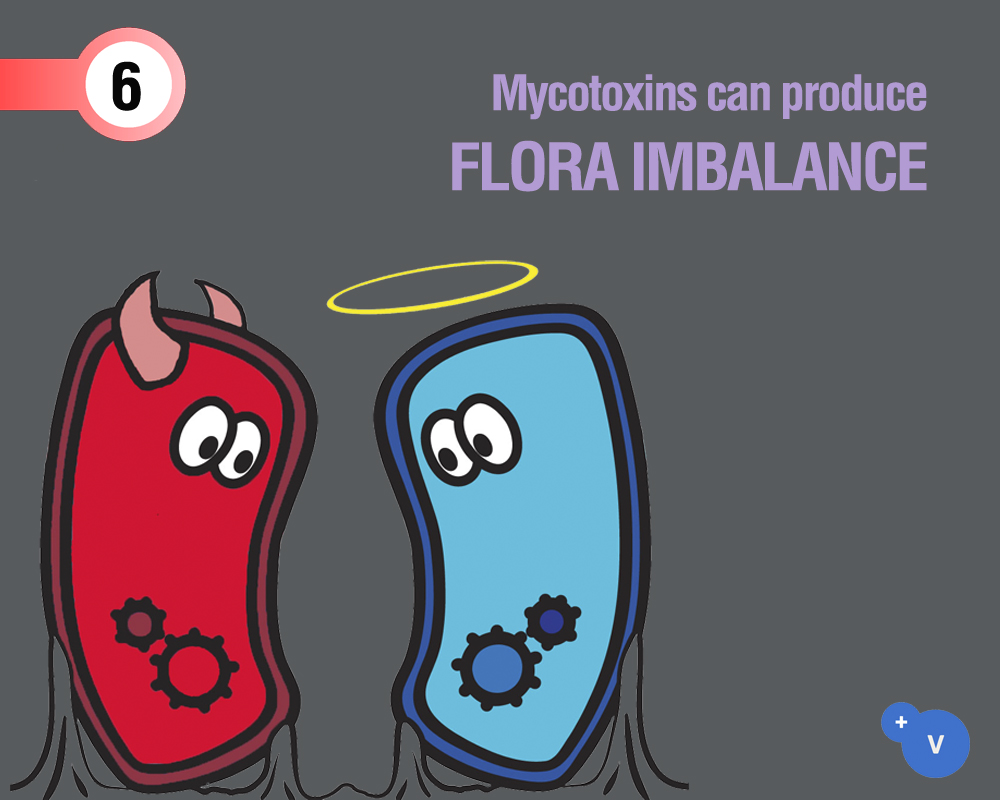
IN CONCLUSION
Digestive system is the main site for the toxic effects of mycotoxins that, 6 possible mechanisms of action, impair feed use and cause huge economical losses, even at concentrations below the limits set by health authorities.
OTHER TIPS
- On onset of mycotoxicosis, administering a vitamin solution might be helpful.
- In case of mycotoxicosis by aflatoxin contamination, increasing the protein content of feed may help to restore normal growth and productivity.
- Prevent mold contamination from the field where the cereal/oilseed grows until the farm.
- Build a HACCP program to avoid contaminated feedstuff from entering your feed production system.
- Pay attention to farm’s environment. Many times molds and mycotoxins come from too wet bedding.
Literature of the article available on request
Products of choice
PlusBind© is a mixture of carefully selected silicates intended for the prevention of diseases and productivity losses related to the presence of all types of mycotoxins. It is indicated in poultry, pigs, aquaculture and ruminants.
The silicates present in PlusBind© have a highly expandable molecular structure. This characteristic gives the product a wide surface available for the adsorption of mycotoxins and therefore allows a high effectiveness at lower doses (0.5-1 kg per ton of feed).
PlusBind Bio© is a mixture of carefully selected silicates intended for the prevention of diseases and productivity losses related to the presence of all types of mycotoxins. It also contains plant extracts with prebiotic effect.
It is indicated in poultry, pigs and aquaculture.
The silicates present in PlusBind Bio© have a highly expandable molecular structure. This characteristic gives the product a wide surface available for the adsorption of mycotoxins and therefore allows a high effectiveness at lower doses (0.5-1 kg per ton of feed).
Do not miss any of our articles!
Subscribe to our monthly newsletter

Certain health statements may not be applicable in your region.

